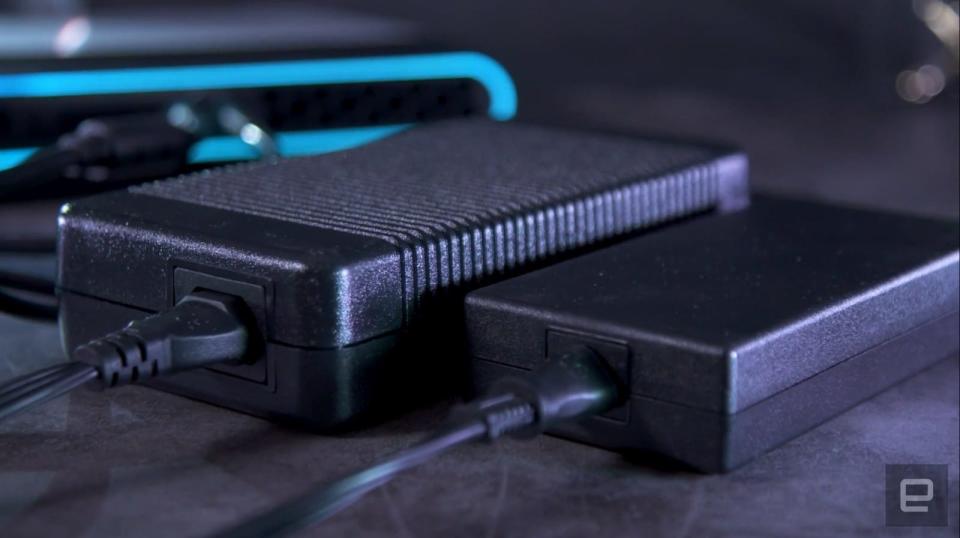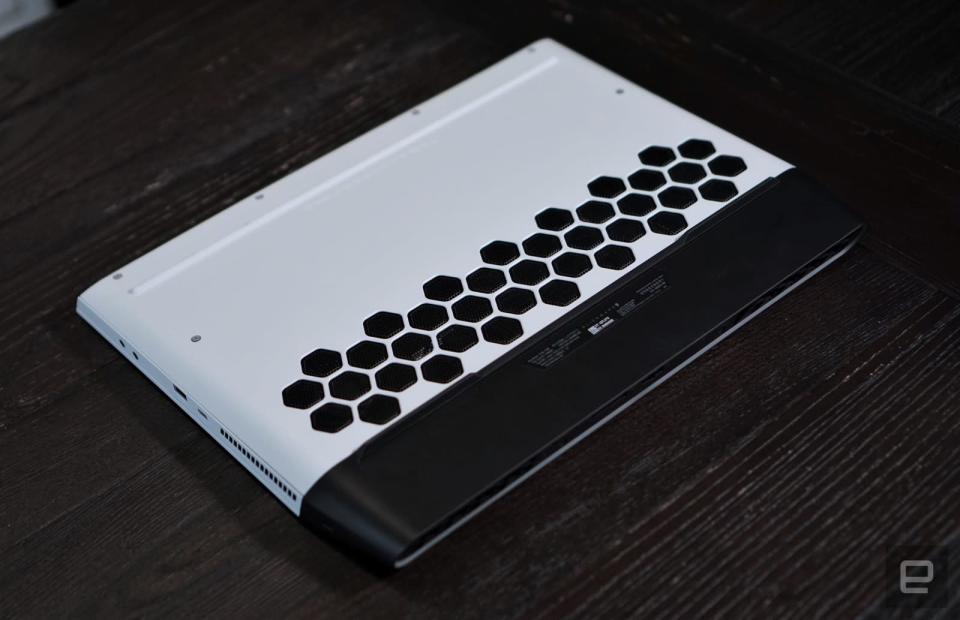Alienware Area-51M review: A gaming desktop stuffed inside a laptop
Incredibly customizable, incredibly niche.
The Area-51M is a unique beast. At first glance, it looks like what we used to expect from gaming laptops: It's an intimidating, hulking machine that doesn't belong in the modern age of slim notebooks. But what makes it special is under the hood. Instead of slightly slower and energy-efficient mobile components, it features powerful gear you'd typically find in desktops, like Intel's octa-core i9-9900K CPU, NVIDIA's full-speed RTX GPUs and up to 64GB of RAM. Best of all, you can upgrade those parts down the line, just like a tower gaming rig. What exactly do you call a machine that looks like a laptop but functions like a desktop? The Area-51M practically defies classification. Let's take the philosophically simple approach for now: It's a gaming laptop like no other. The first thing you'll notice about the Area-51M is that it's big -- very big. It weighs 8.5 pounds, it's up to 1.7 inches thick and it has a huge 17.3-inch screen. That seems practically unthinkable now that every PC maker is racing to make their gaming laptops slimmer and lighter. Even Dell is doing that with the Alienware M15 and M17. But compared to the last full-size 17-inch Alienware notebook, which weighed 9.7 pounds, the Area-51M is significantly more portable. And don't forget it wasn't that long ago that gamers were perfectly happy with laptops over 10 pounds. The second thing that sticks out is that the Area-51M looks completely unlike any other Alienware notebook. It's the first step toward a cleaner, more futuristic style. Instead of the sharp lines and aggressive aesthetic Alienware used to rely on, the Area-51M actually has some rounded edges. And rather than being draped in all black, there's finally a lighter color option. Add in some LEDs around the rear ports and you have something that looks more like a sci-fi prop than a gaming notebook. There's no doubt Dell is trying to make a statement with the Area-51M. It's targeted at gamers who demand peak performance above all else. That's all thanks to Intel's desktop Z390 chipset and all the power-hungry, battery-killing components it supports. There's the Core i9-9900K, the fastest gaming chip Intel has ever produced. NVIDIA's RTX 20-series cards are the most powerful GPUs on the market today, and they enable new features like real-time retracing. It's also worth noting that Dell isn't plugging in the slower Max-Q versions of those chips -- they're full speed and overclockable. And you can also throw in up to three separate drives, including speedy M.2 SSDs, larger hybrid drives and a variety of RAID 0 configurations. It's no surprise that the Area-51M gets only 1.5 hours of battery life -- the least of Dell's concerns. The massive 17.3-inch display also packs in most of the features gamers demand today, including a fast 144Hz refresh rate and thin bezels. There's also optional G-SYNC support and Tobii eye tracking. Unfortunately, the screen is only available with 1080p resolution at the moment. That's not a major issue, since many players are more interested in getting the highest frame rates possible. But given how Dell is positioning this computer, I'd expect higher-resolution displays eventually. That said, the Area-51M's 1080p screen is no slouch. Everything looked silky smooth as frame rates crept above 100 fps in Overwatch, Forza Horizon 4 and Hitman 2. Colors popped off the screen, and it was bright enough for me to catch fine details as I sped through snowy roads in Forza. Unfortunately, there's no HDR support, which is slowly making its way to other gaming laptops. Given all of its hardware, the Area-51M will basically never disappoint you, no matter what game you throw at it. In the Hitman 2 benchmark, I saw around 105 fps on average, with all the graphics settings on maximum. And in Forza Horizon 4, I saw an eye-watering 124 fps. With all that extra power, you can also supersample many games to render them at a higher resolution, which makes them look even crisper in 1080p. Alienware's elaborate cooling, which includes two large fans that suck fresh air from below and spit heat out of the rear vents, managed to keep the GPU under 83 degrees Celsius. You have plenty of control over the cooling profiles, so you can rev the fans up for longer play sessions and make them nearly silent when you're browsing the web. The Area-51M did a great job of managing all of that on its own when I chose the standard profile. As you'd expect, this is a system that's constantly spewing out warm air, so it might heat up small rooms. That could be a side benefit in the winter, but it's not ideal for summer months. The Area-51M relies on two large power adapters to keep everything running. It's annoying but unavoidable since AC chargers top out at 330 watts: Having another charger is simply necessary to keep this machine going, especially since it's relying on desktop parts. When you're not gaming, a single adapter is enough to power the Area-51M, but you'll need to have both plugged in once you start taxing the GPU. Alienware isn't the only company going this route; the ASUS ROG Mothership also relies on two power supplies. It's simply a physics problem as gaming laptops get more demanding. To get to the Area-51M's internals, you just have to take off six Phillips-head screws on the bottom of the case. That gives you direct access to four RAM slots, the storage disk and battery. But you'll have to dig even further to reach the CPU and GPU: That involves removing another layer of the case, the rear port hump and the fan assembly and disconnecting plenty of components. It's not something you'll want to do often, and you'll also have to be extra careful about reconnecting everything. If this whole process sounds like a headache, that's a sign that the Area-51M might not be for you. Even if you're used to upgrading desktop PC components, dealing with the confined space of a laptop case -- no matter if it's a large one like the Area-51M -- is going to be frustrating. Still, if you can afford it and don't mind the annoying disassembly process, the Area-51M gives you an unprecedented amount of upgradability in a laptop. If you're tempted by a new Intel chip in a few years, you can throw that in. And while the GPU rests in a proprietary Alienware module, the company says it'll have new components coming later this year. There's no guarantee it'll keep pace with whatever NVIDIA releases in the near future, though, so you're making a bit of a gamble there. Unfortunately, the components you can't upgrade on the Area-51M -- the keyboard and the trackpad -- are the ones that need the most improvement. While the keyboard looks and feels great at first, with RGB LEDs and 2.2mm of travel, it feels a bit flimsy while gaming. I'm also worried about its long-term durability. When we first received the Area-51M, one of the keys flew off within 10 minutes of turning it on. Normally, I'd just snap it back into place, but somehow the plastic spring mechanism underneath was completely shattered. This is the sort of thing Dell would fix under warranty if it happened to you, but it's still disheartening to see in such an expensive machine. And for the record, it later sent us another unit to test. The trackpad, meanwhile, feels surprisingly cramped for a modern laptop. We're used to ultrathin notebooks giving us a ton of space to swipe around, but with the Area-51M, my fingers always felt boxed in. Alienware also opted for an old-school two-button mechanism instead of letting you click into the trackpad. Using it made me feel like I was transported back in time. Of course, gamers will be relying on mice most of the time, but it would have been nice to see Dell show some innovation with its design. Even moving over the trackpad from the slimmer Alienware M15 would have been an improvement. Given its massive size, Alienware was able to cram in just about every port you'd need. There are three USB type-A ports around the sides and single USB-C Thunderbolt 3 connection as well as HDMI, DisplayPort, Ethernet, headphone and microphone ports. And of course, there's the proprietary Alienware Graphics Amplifier connection, which lets you plug in the company's external GPU adapter for even more power. To be honest, that seems like overkill for a machine that already packs in a desktop's worth of performance, but I'm sure there are graphics-hungry gamers out there who will take advantage of it. After spending several days with the Area-51M, I'm both awestruck and a bit disappointed. Sure, it's incredibly powerful and upgradable, but I'd be hard-pressed to recommend it to most gamers. Given its size and price -- starting at $1,950 but configurable to over $5,000 -- most gamers would be better off with any of the notebooks that are less than five pounds that we've been seeing over the past year, like the ASUS Zephyrus series, the Gigabyte Aero 15 and the MSI GS65 Stealth Thin. They can also double as decent productivity machines for getting work done on the go, and some even have respectable battery life. Most important, they'll get you most of the performance you want without crushing your back and wallet. Alienware has made one thing clear with the Area-51M: It's doing something nobody else is. So for a certain subset of gamers -- like professional streamers or eSports players who want to stand out from the pack -- it probably doesn't matter that there are lighter and cheaper options out there. They want the powerful new laptop that has the guts of a desktop, and they'll pay whatever it takes to have it. The Area-51M might not be the wisest purchase, but it's certainly one of the wildest choices today.

Alienware Area-51M | 1:30 |
Gigabyte Aero 15 Y9 (2019) | 3:30 |
Alienware M15 (2018) | 8:30 |
Razer Blade (2018) | 8:50 |
MSI GS65 Stealth Thin | 7:01 |
ASUS ROG Zephyrus | 1:50 |

PCMark 7 | PCMark 8 (Creative Accelerated) | 3DMark (Sky Diver) | ATTO (top reads/writes) | |
|---|---|---|---|---|
Alienware Area-51M (3.6-5GHz Intel i9-9900K, NVIDIA RTX 2080) | 8,555 | 10,052 | 55,898 | 2.9GB/s / 2.4GB/s |
Gigabyte Aero 15 Y9 (2019) (2.9-4.8GHz Intel i9-8950HK, NVIDIA RTX 2080 Max-Q) | 7,305 | 7,989 | 37,665 | 2.6GB/s / 1.46GB/s |
Alienware M15 (2018) (2.2-4.1Ghz Intel i7-8750H, NVIDIA GTX 1070 Max-Q) | 6,276 | 5,293 | 35,991 | 2.56GB/s / 432MB/s |
Razer Blade (2018) (2.2-4.1GHz Intel i7-8750H, NVIDIA GTX 1070 Max-Q) | 6,699 | 5,434 | 29,932 | 2.1GB/s / 1.3GB/s |
MSI GS65 Stealth Thin (2.2-4.1GHz Intel i7-8750H, NVIDIA GTX 1070 Max-Q) | 6,438 | 5,696 | 32,288 | 542MB/s / 482MB/s |
ASUS ROG Zephyrus (2.8GHz Intel Core i7-7700HQ, NVIDIA GTX 1080) | 6,030 | 7,137 | 31,624 | 3.4GB/s / 1.64GB/s |





















